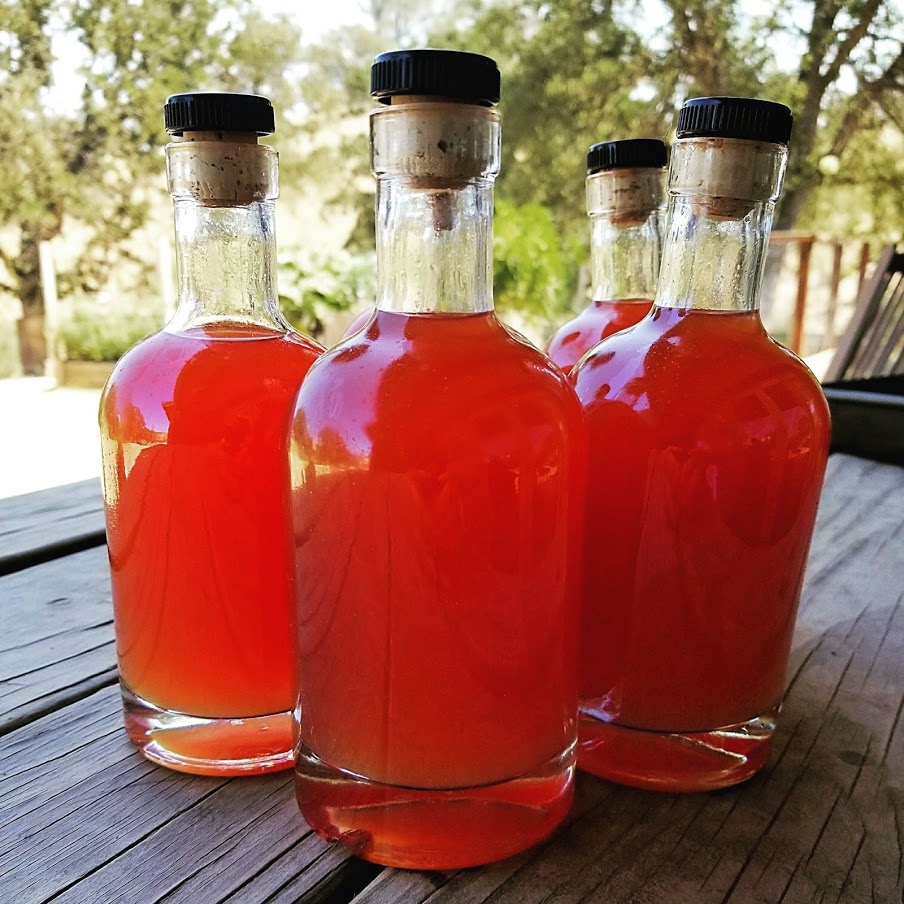
Citrus-Cello
On July 5, 2018 by Christy LarsenI always have a citrus-cello project in the works. It is the final resting place for all the excess citrus that we grow and gather. I currently have a limoncello & arancello in the works. Limoncello is an Italian digestivo, that is most popular on the Island of Capri…but can be found all over Italy, and now the States as well. Arancello isn’t quite as popular, nor is it as authentic, but I love it anyway. It is a delicious liqueur and has many uses beyond drinking. I, for example, toss it into my homemade jam just before canning and often use it as a soak for my olive oil cake. Although making this takes passive time, it’s really easy…and makes a wonderful gift. Start now for the holidays.
You need lots of fruit–use lemons, blood oranges, mandarins, grapefruit, whatever you have on hand. We mostly use the peel, but will also need to juice the fruit and store it for later.
Waste not, want not; so here are some ideas for the rest of the lemon:
Cut in half, pour some salt on it and tame your elbows (Barbra Streisand does it and so should we).
Juice the lemons and make the required sugar syrup in advance (but keep it in the freezer, so it doesn’t get weird).
Make lemon curd…better yet, make lemon chicken…ooh what about lemon bars? Those are my fave.
Back to the recipe. Wash and dry about 10-15 lemons {or fruit of choice}. The lemons should be unwaxed. Remove the peels. Now, this is very important…you do not want the pith. That is the white stuff that hugs the peel like a preschooler hugs his mom on the first day of school. Remove it all…you only want the yellow part. The pith is bitter and is not good for your end result. Place all the peels in a large glass or ceramic jar with a tight-fitting lid. Pour 1 bottle of vodka or grain alcohol over it. You do not need expensive vodka for this, you want the alcohol content, but the theory is that you will be changing the flavor of it, so don’t break the bank on this one.
Put the top on the jar, date it, and put it away in a cool dark place for a minimum of 2 weeks but as long as 3 or 4 months. I tend to steep mine for a long time; mostly because I forget.
When you see that all of the lemon peels have lost their color and/or it’s been at least 2 weeks you can move onto the next step.
In a heavy saucepan place 3 cups of water, 1/2 cup of strained lemon juice, 3 cups sugar and 3 Tbs honey. Boil over low heat until the sugar is completely dissolved and the mixture is clear. Don’t let it go too long and get thick and gooey. Let cool.
Pour the syrup into your glass jar with the lemon peels and vodka. Cover and let steep for another week (or longer if you have the time). When you are ready to bottle your limoncello, strain the liquid using cheesecloth or fine sieve. Squeeze all that you can from the peels and then throw away (or roll in sugar and dehydrate for a sweet and boozy garnish). Bottle the liquid in clean jars and seal tightly.
Like revenge, this is best served cold…store it in the freezer.
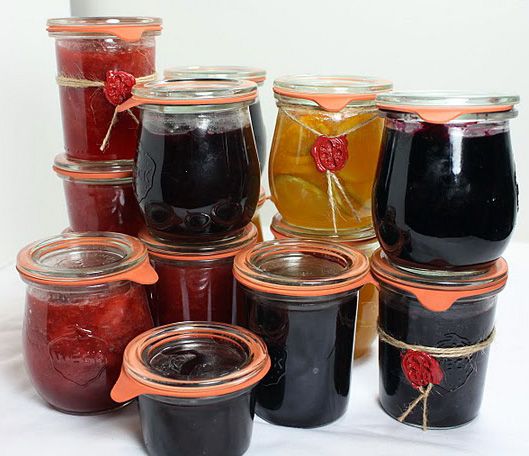
Blueberry Grapefruit Jam
On October 8, 2015 by sixtyacrebakerI have a freezer full of summer fruits; gathered in their peak and frozen to preserve freshness. It is my own secret garden. This jam combines the summer goodness blueberries hold, with beautiful winter grapefruit. I love it spooned onto toast, but I also have been using it as topping for cheesecake, filling for my homemade pop tarts,and as a delicious swirl in my morning yogurt.
blueberry grapefruit jam
1 tsp grated fresh ginger
2 grapefruits–flesh only
12 cups blueberries–fresh or frozen
1 tsp cardamom
generous pinch salt
3 cups sugar
1 pouch pectin
Slightly mash the blueberries and place in a heavy pot. Add the sugar, salt, ginger, grapefruit segments and an juice you can capture, and cardamom. Bring to a boil, reduce heat and let simmer about 5 minutes. Increase heat and bring to a boil. Stir in the pectin and boil for a full 60 seconds. Turn off heat and place in sterilized jars. Process for long term storage. Use the ball canning guide for time and process </s[an>
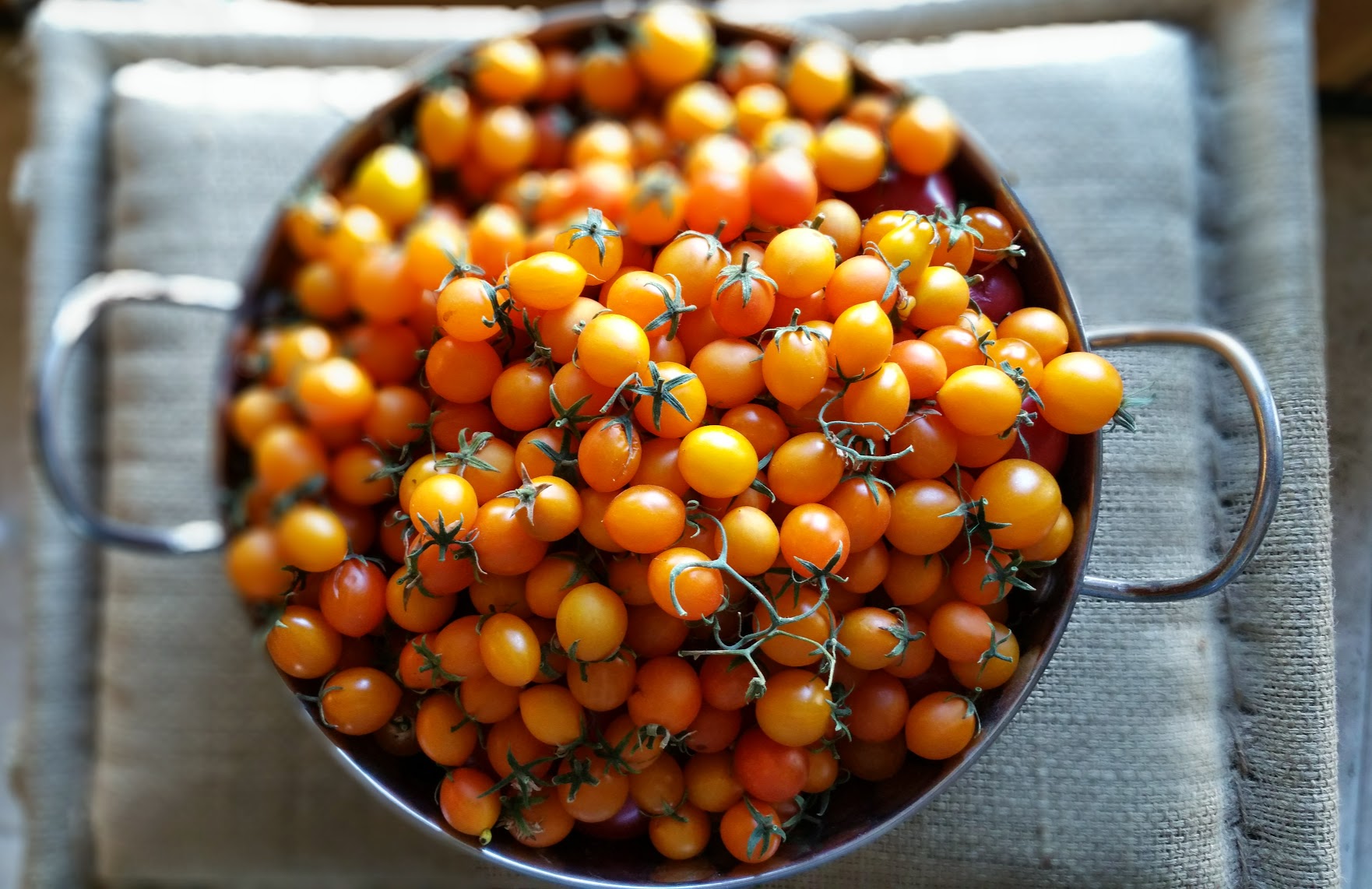
Tomatoes
On October 24, 2014 by sixtyacrebakerI have loads of these gorgeous, albeit small, tomatoes. My sink is a bath of hot soapy water, as I prepare jars for canning. My counter tops look as if a produce van exploded just outside the kitchen window. When it is all said and done, I will have plenty of jars for winter, as well as gifting. Question is…what shall I make? Tomato jam, sauce, chutney? So many possibilities. What I do know for sure is that I will be making a big jug of tomato infused vodka for the day after, the night before.
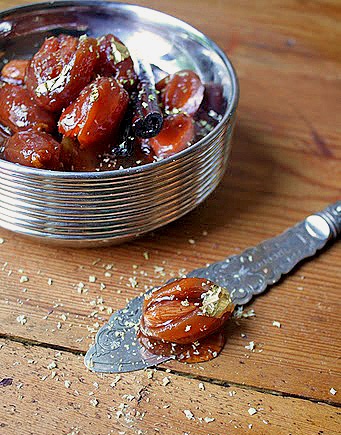
Sugar Poached Dates
On August 25, 2011 by sixtyacrebakerThe late summer heat has me dreaming of all things Moorish; exotic spices, grassy mint tea, souks with dark corners shrouded in silk -thread canopies, and gorgeous sweets like these. fresh dates have a pleasant albeit astringent taste. The longer they sit on your counter, the softer and sweeter they become. But, they are meant to be eaten as is. Dried dates are sweet and chewy and are great fodder for nuts, cheese and other salty bits. These fresh dates are really best left plain or poached to soft submission. The process is lengthy, but I promise the reward is a pot full of golden amber fruit, stuffed with nuts, in a pool of rich treacle heady with spice.
Sugar Poached Dates
this recipe takes 2 days to complete
Step One
100 fresh dates–peeled
water to cover
3 Tbs orange blossom water
parchment paper
100 non-pareil almonds
Place the dates in a pot large enough to hold the dates and water enough water to cover. You will want the water to come about 1 1/2 inches higher than the top of the dates. Add the orange blossom water. Cut the parchment paper to a round that will fit just inside of the pot, and then cut a small 1/2″ circle out of the middle of it. Place it on top of the water and simmer the dates, about an hour, until they are soft but not gushy. the parchment paper will keep the dates submerged in the water. drain and let cool–discard parchment. Using a small knife cut a slit in the date and remove the pit. do not cut completely in half, just enough to remove the pit. Replace the pit with an almond, and close the date around it.
Step Two
3″ lemon peel-pith removed
3″ orange peel-pith removed
1 cinnamon stick
4 green cardamom pods–lightly crushed
1 Tbs lemon juice
1/2 vanilla bean
3 Tbs honey
1 Tbs orange blossom water
3 cups water
3 cups sugar
Place all ingredients in a heavy pot. Cook to dissolve the sugar. Add back dates and simmer on low for 30 minutes. Turn off heat and let sit 12 hours or overnight-covered–once cooled, place in the refrigerator.
Step Three
Remove the dates from the syrup once again, reserving and measuring syrup. Add enough water to make 5 cups. However much water you added, add an equal amount of sugar. (example, if you needed to add 1 cup of water to equal 5 cups total syrup, then also add 1 cup of sugar). Stir
add back the dates and simmer, very gently, until the syrup is very thick and dates are a nice amber color. This may take 1 to 2 hours. Do not just let it boil away–keep a good eye on it. The syrup should not get any more dense than corn syrup.
Serve as is or sprinkle grated pistachio nuts and dress with gold leaf. Place a few over a bowl of plain yogurt or serve with a simple lemon tea cake. I can’t help but think these would make a delicious amuse bouche before a colorful Moroccan meal of cumin and carrot soup, lamb tagine and lemon couscous
salaam
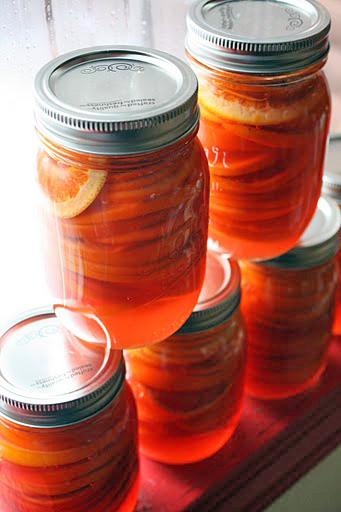
Sugared Oranges
On April 15, 2011 by sixtyacrebakerA couple of weeks ago my good friend Julie handed me two grocery bags stuffed full of blood oranges. Gobs and gobs of amazingly sweet, stunningly hued orbs of delight. Best part. They were all mine. For the past fortnight, I have been concocting
all sorts in my kitchen. First up: sugared oranges.
Sugared Oranges
*to make approx 9 pint jars
blood oranges-or thin skinned oranges
(this recipe uses about 180-200 orange slices)
granulated sugar
ground ginger (optional)
6 cups granulated sugar
3 cups water
1 cup blood orange juice
2-1″ knobs of fresh ginger
Choose your oranges carefully. Make sure they have thin skin and that they are not so large that they will not fit into the jars you are going to preserve them in. Slice the oranges in rings no thicker than 1/8″ beginning at stem end. Arrange in a casserole dish in a single layer, slightly overlapping. Once you have your first layer, sprinkle sugar to lightly cover. Lightly sprinkle ground ginger on top as well (no more than 1/8 tsp per layer). Continue with a second layer of oranges and repeat with the sugar and ginger. Continue until you have reached your desired number of orange slices. Remember to reduce the amount of syrup if you are reducing the number of oranges. Sprinkle sugar and ginger on the top layer of oranges, cover with plastic wrap and allow to sit for an hour at room temperature. After 1 hour or up to 2 (if waiting longer than 2 hours, place in refrigerator) lightly pack your oranges into sterilized jars–each pint jar will hold approximately 20 pieces.
make the syrup
Place the sugar, water, blood orange juice and ginger in a saucepan over medium heat. Add the leftover juices from your oranges as well. Bring to a boil and stir until the sugar is completely dissolved and the syrup appears clear. Remove from heat. Using a ladle, spoon the hot syrup over the oranges, making sure there are no gaps of air. Use a knife to maneuver the oranges so the syrup can seep through. Leave a 1/4″ gap at the top of the jar. Seal the jar and process in a water bath per standard canning methods.
I processed my jars for 20 minutes at high altitude, but i cannot guarantee that this method will be appropriate for your batch.
And now for the big question: what would you use these for? Well, coming soon is a cake recipe using sugared oranges. You can also use for cocktail garnish-using the syrup in the beverage. Dry them in a slow oven and dip in chocolate. Top cupcakes and cheesecakes. Sweeten your morning yogurt. Garnish grilled chicken. The list is endless…